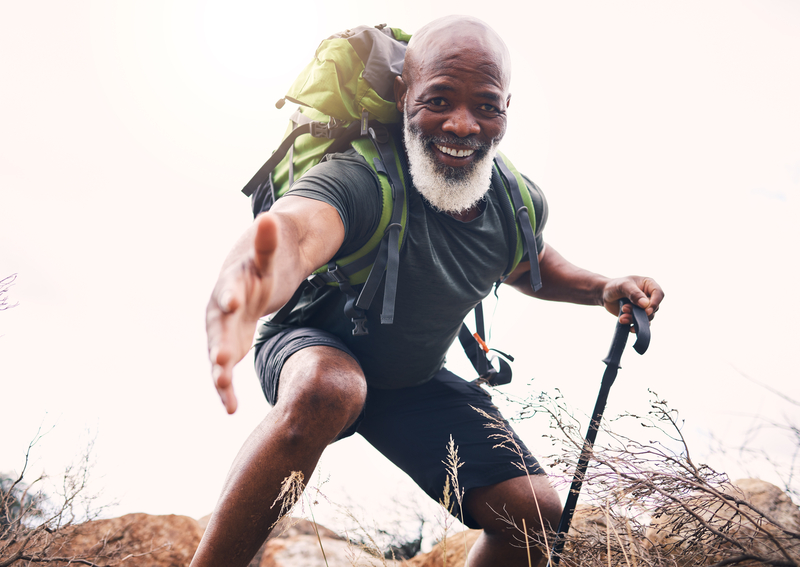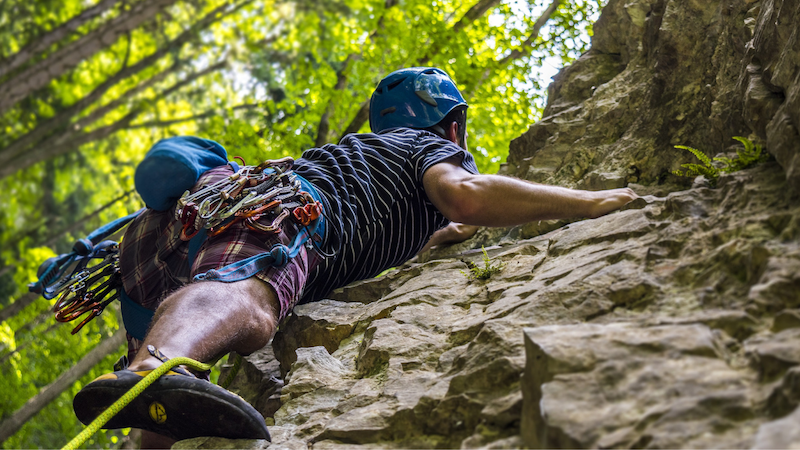In today’s fast-paced world, finding time for physical activity can be challenging. However, engaging in regular exercise is crucial for maintaining good health and well-being. Hiking emerges as an accessible and enjoyable form of exercise that offers numerous physical benefits. This article delves into the positive impact of hiking on cardiovascular health, weight loss, muscle building, bone density, and sleep quality. Additionally, it provides practical tips for choosing the perfect hiking trails and concludes with key takeaways to motivate you to embrace hiking as a healthy lifestyle choice.

Hiking: a low-impact cardio workout
In the realm of cardiovascular health, hiking reigns supreme as a low-impact cardio workout that effectively strengthens your heart and enhances your overall cardiovascular health. Unlike high-impact exercises that can strain your joints, hiking provides a gentler approach to fitness, making it an ideal choice for individuals of all fitness levels.
As you embark on regular hiking expeditions, you’ll notice a remarkable transformation in your cardiovascular system. Your heart, the engine that powers your body, becomes stronger and more efficient at pumping blood throughout your body. This increased pumping capacity leads to lower resting heart rates and improved circulation, ensuring that oxygen-rich blood reaches every corner of your body.
Beyond strengthening your heart, hiking also works wonders in lowering your blood pressure and cholesterol levels. Hypertension and high cholesterol are significant risk factors for cardiovascular diseases, but hiking can effectively combat these concerns. By engaging in regular hikes, you can naturally reduce your blood pressure and maintain healthy cholesterol levels, significantly reducing your risk of heart disease, stroke, and type 2 diabetes.
In essence, hiking serves as a powerful ally in your quest for cardiovascular health. Its low-impact nature, coupled with its ability to strengthen your heart, lower blood pressure, and reduce cholesterol levels, makes it an exceptional choice for individuals seeking to improve their overall well-being. Embrace the joys of hiking, and embark on a journey towards a healthier, more vibrant you.
Hiking for weight loss
In the realm of weight loss, hiking stands tall as a champion. This low-impact aerobic activity not only torches calories but also jumpstarts your metabolism, leaving you with a calorie-burning furnace that continues to sizzle long after your hike has ended.
While hiking, your body taps into its fat reserves, converting stored fat into energy to fuel your ascent. This process leads to a reduction in body fat, contributing to your weight loss goals.
Moreover, hiking stimulates the production of endorphins, those feel-good hormones that can help curb your appetite. This natural appetite suppressant can prevent overeating and emotional eating, further aiding your weight loss efforts.
In addition to burning calories and curbing your appetite, hiking also promotes muscle building. As you navigate challenging terrains, your muscles are put to work, leading to increased muscle mass. This, in turn, boosts your metabolism, as muscles require more energy to maintain themselves compared to fat.
The combination of calorie burning, metabolism boost, appetite reduction, and muscle building makes hiking an exceptional choice for individuals seeking to shed those extra pounds. So, lace up your hiking boots and embark on a journey towards a slimmer, healthier you.
Building muscle with hiking
Hiking is a fantastic way to build muscle, particularly in your legs and core. The uneven terrain challenges your muscles in unique ways, and adding a backpack while hiking increases resistance. Over time, regular hiking can help you gain lean muscle mass, enhancing your overall strength and fitness.
One of the primary muscle groups targeted while hiking is the quadriceps, located on the front of your thighs. These muscles are responsible for extending your legs and play a crucial role in maintaining stability during ascents and descents. Hiking also engages the hamstrings, located on the back of your thighs, which help flex your knees and provide support while hiking uphill.

In addition to strengthening your legs, hiking also works your core muscles, which include your abdominal and back muscles. These muscles are essential for maintaining good posture and balance, and they play a vital role in supporting your spine while carrying a backpack. As you hike, your core muscles are constantly engaged to help you stay upright and prevent fatigue.
Hiking also targets your glutes, the muscles located in your buttocks. These muscles are responsible for hip extension and provide power when climbing hills or stairs. By engaging your glutes while hiking, you can improve your overall strength and mobility.
Hiking and bone density
Hiking is an excellent way to improve bone density and reduce the risk of osteoporosis. The weight-bearing nature of hiking places stress on the bones, stimulating them to become stronger. Moreover, hiking helps maintain a healthy weight, reducing the risk of obesity, a significant risk factor for osteoporosis.
As we age, our bone density naturally decreases, increasing the risk of fractures and osteoporosis. Regular hiking can help counteract this decline by maintaining or even increasing bone density. This is particularly beneficial for postmenopausal women and older adults, who are more susceptible to osteoporosis.
In addition to increasing bone density, hiking improves balance and coordination. This reduced risk of falls and fractures further contributes to bone health and overall well-being.
Improved sleep quality through hiking
Hiking can also significantly improve the quality of your sleep. One of the primary reasons for this is the reduction of stress. As hiking immerses you in nature, it provides a tranquil environment that helps alleviate tension and anxiety. The physical exertion involved in hiking further contributes to stress relief by releasing endorphins, the body’s natural feel-good chemicals. With reduced stress levels, you are more likely to experience restful and restorative sleep.
Another factor that contributes to improved sleep quality through hiking is increased exposure to natural light. When you hike during the daytime, your body receives ample sunlight, which helps regulate your circadian rhythm. This natural regulation of your body’s internal clock promotes better sleep-wake patterns, ensuring that you feel more refreshed and energized throughout the day.
Tips to consider while choosing where to hike
Choosing the right hiking trail is crucial to ensuring a safe and enjoyable hiking experience. Here are some key factors to consider when selecting a trail:
- Assess Your Fitness Level: Choose a trail that matches your fitness level. If you’re new to hiking, start with shorter, less challenging trails and gradually increase the difficulty as you gain experience and endurance. Consider factors like distance, elevation gain, and terrain when making your decision.
- Research the Terrain: Familiarize yourself with the terrain of the trail. Some trails may be rocky, muddy, or have steep inclines and descents. Choose a trail that suits your comfort level and abilities. If you have any concerns, consult with experienced hikers or local hiking groups for recommendations.
- Check the Weather Forecast: Pay close attention to the weather forecast before setting out on your hike. Some trails may become dangerous in certain weather conditions, such as heavy rain, high winds, or extreme temperatures. Always be prepared for changing weather conditions by bringing appropriate clothing and gear. It’s also a good idea to keep the contacts for nearby tow truck services or a local locksmith service handy with you, in case of emergencies such as your car getting damaged or getting locked out of car.
- Choose the Right Time of Day: Consider the time of day when planning your hike. Hiking during the cooler hours of the morning or evening can be more comfortable, especially in warmer climates. Avoid hiking during the hottest part of the day, particularly in exposed areas, to minimize the risk of heat-related illnesses.
- Bring the Right Gear: Ensure you have the appropriate gear for your hike. This includes comfortable hiking shoes or boots, breathable clothing, a water bottle, snacks, a first-aid kit, and a map or GPS device. Depending on the length and difficulty of the trail, you may also need trekking poles, a flashlight, and a whistle.
- Hike with a Buddy or Group: Hiking with a partner or a group can enhance your safety and enjoyment. You can support each other, share the experience, and assist in case of emergencies. Inform someone about your hiking plans, including the trail you intend to take and your expected return time.

Final Thoughts
In conclusion, hiking stands as a remarkable activity that bestows a wealth of benefits upon its devoted participants. From enhancing cardiovascular health to promoting restful slumber, its impact on our overall well-being is undeniable. By fortifying our bones and sculpting our muscles, hiking empowers us to embrace an active lifestyle and relish the joys of physical fitness.
As you embark on your hiking journey, remember to prioritize safety and comfort. Choose trails that align with your fitness level, and be mindful of weather conditions. Invest in appropriate gear that provides support and protection, ensuring a pleasurable and rewarding experience.
Incorporating hiking into your routine is a decision that promises to enrich your life in profound ways. Embrace the opportunity to connect with nature, discover the beauty of your surroundings, and reap the rewards of improved physical and mental well-being. Let hiking become your gateway to a healthier, happier, and more fulfilling life.
